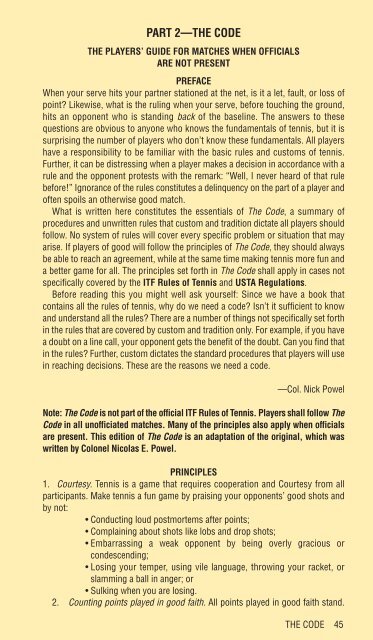FRIEND AT COURT 2010 - USTA.com
FRIEND AT COURT 2010 - USTA.com
FRIEND AT COURT 2010 - USTA.com
Create successful ePaper yourself
Turn your PDF publications into a flip-book with our unique Google optimized e-Paper software.
PART 2—THE CODE<br />
THE PLAYERS’ GUIDE FOR M<strong>AT</strong>CHES WHEN OFFICIALS<br />
ARE NOT PRESENT<br />
PREFACE<br />
When your serve hits your partner stationed at the net, is it a let, fault, or loss of<br />
point? Likewise, what is the ruling when your serve, before touching the ground,<br />
hits an opponent who is standing back of the baseline. The answers to these<br />
questions are obvious to anyone who knows the fundamentals of tennis, but it is<br />
surprising the number of players who don’t know these fundamentals. All players<br />
have a responsibility to be familiar with the basic rules and customs of tennis.<br />
Further, it can be distressing when a player makes a decision in accordance with a<br />
rule and the opponent protests with the remark: “Well, I never heard of that rule<br />
before!” Ignorance of the rules constitutes a delinquency on the part of a player and<br />
often spoils an otherwise good match.<br />
What is written here constitutes the essentials of The Code, a summary of<br />
procedures and unwritten rules that custom and tradition dictate all players should<br />
follow. No system of rules will cover every specific problem or situation that may<br />
arise. If players of good will follow the principles of The Code, they should always<br />
be able to reach an agreement, while at the same time making tennis more fun and<br />
a better game for all. The principles set forth in The Code shall apply in cases not<br />
specifically covered by the ITF Rules of Tennis and <strong>USTA</strong> Regulations.<br />
Before reading this you might well ask yourself: Since we have a book that<br />
contains all the rules of tennis, why do we need a code? Isn’t it sufficient to know<br />
and understand all the rules? There are a number of things not specifically set forth<br />
in the rules that are covered by custom and tradition only. For example, if you have<br />
a doubt on a line call, your opponent gets the benefit of the doubt. Can you find that<br />
in the rules? Further, custom dictates the standard procedures that players will use<br />
in reaching decisions. These are the reasons we need a code.<br />
—Col. Nick Powel<br />
Note: The Code is not part of the official ITF Rules of Tennis. Players shall follow The<br />
Code in all unofficiated matches. Many of the principles also apply when officials<br />
are present. This edition of The Code is an adaptation of the original, which was<br />
written by Colonel Nicolas E. Powel.<br />
PRINCIPLES<br />
1. Courtesy. Tennis is a game that requires cooperation and Courtesy from all<br />
participants. Make tennis a fun game by praising your opponents’ good shots and<br />
by not:<br />
• Conducting loud postmortems after points;<br />
• Complaining about shots like lobs and drop shots;<br />
• Embarrassing a weak opponent by being overly gracious or<br />
condescending;<br />
• Losing your temper, using vile language, throwing your racket, or<br />
slamming a ball in anger; or<br />
• Sulking when you are losing.<br />
2. Counting points played in good faith. All points played in good faith stand.<br />
THE CODE 45







![COMPLETE - 2013 Tournament Schedule [11_20_12] - USTA.com](https://img.yumpu.com/21906454/1/190x245/complete-2013-tournament-schedule-11-20-12-ustacom.jpg?quality=85)









